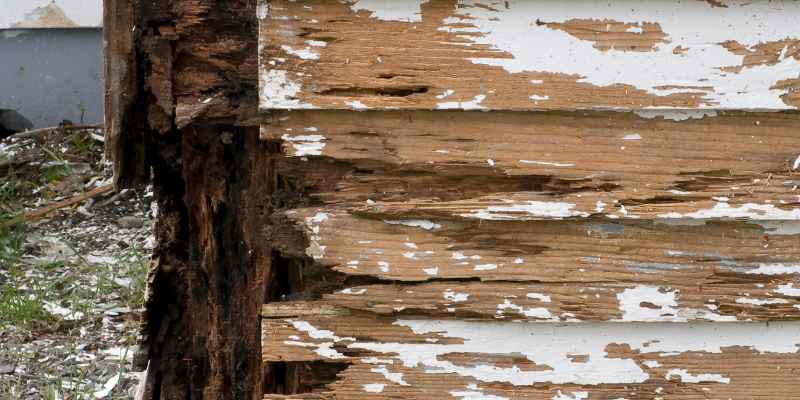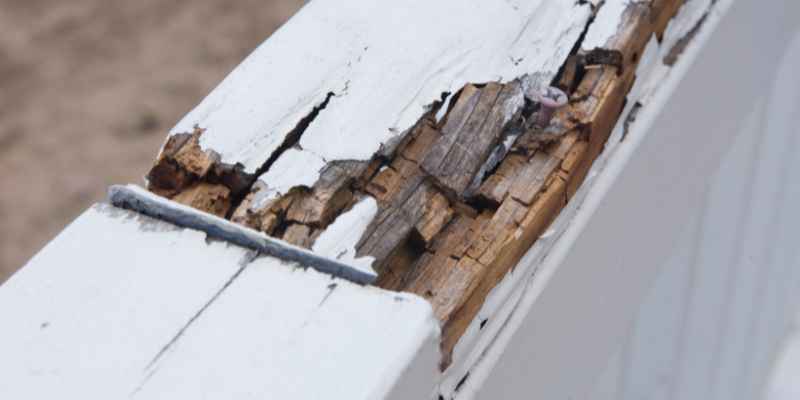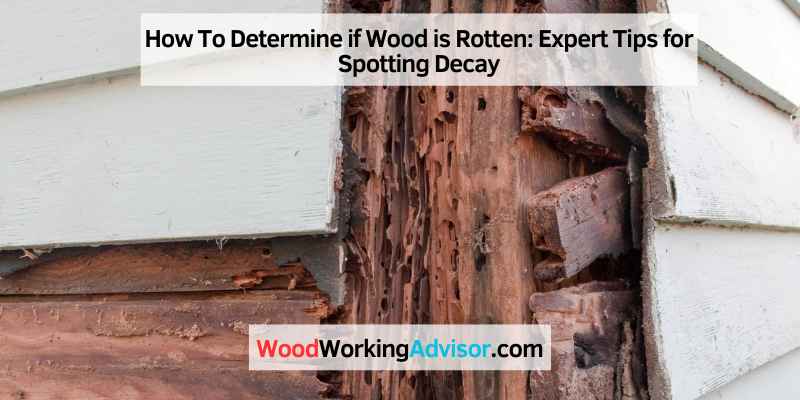To tell if wood is rotten, look for signs such as a soft and spongy texture, visible cracks or holes, and a musty smell. Rotten wood can compromise the structural integrity of your furniture, floorboards, or outdoor structures, so it’s important to identify and address the issue promptly.
Wood is a versatile and durable material used in various applications, from furniture and flooring to buildings and outdoor structures. However, over time, wood can deteriorate and rot due to moisture, pests, and fungal growth. Identifying rotten wood is crucial to prevent further damage and potential safety hazards.
We will guide you through the telltale signs of rotten wood and provide some tips on how to address the issue effectively. By learning how to recognize and treat rotten wood, you can protect your investments and ensure the longevity of your wooden structures.
Common Signs Of Wood Decay
In order to determine if wood is rotten, you need to be familiar with the common signs of wood decay. Paying attention to these signs can help you identify and address any structural issues before they become serious problems.
Fungal Growth
Fungal growth is one of the most noticeable signs of wood decay. When wood is exposed to moisture for a prolonged period of time, fungi can start to grow on its surface or within its fibers. This growth can take on various forms, such as a black, green, or white discoloration, or the appearance of mushrooms or mold. Any visible fungal growth is a clear indicator that the wood is rotting.
| Sign | Description |
|---|---|
| Black discoloration | Indicates the presence of rot-causing fungi |
| Green discoloration | May suggest the presence of algae or moss, which can contribute to wood decay |
| White discoloration | Commonly caused by white rot fungi |
Soft And Crumbly Texture
Another obvious sign of wood decay is a soft and crumbly texture. When wood starts to decay, it loses its structural integrity and becomes weakened. If you notice that the wood in question feels spongy or easily breaks apart when touched, it is likely rotten. This decay can occur both on the surface and within the wood, so it’s essential to thoroughly inspect the entire piece.
If you suspect wood decay, try probing the wood with a screwdriver or other sharp object. If it easily penetrates the wood or if you notice the presence of sawdust-like decay residue, it’s a strong indication that decay is present.
By recognizing these common signs of wood decay, you’ll be empowered to take appropriate measures to address the issue and prevent further damage. Prompt action can help protect the structural integrity and longevity of wood-based structures and items.

Inspecting Exterior Wood
When it comes to maintaining the structural integrity of your home, inspecting the exterior wood is crucial. The weather elements can take a toll on exterior wooden surfaces, leading to rot over time. By regularly checking for signs of rot, you can catch it early and prevent further damage. In this section, we will discuss how to inspect exterior wood for rot, focusing on two important aspects: checking for cracks and splits, and looking for moisture damage.
Check For Cracks And Splits
One of the first things to look for when inspecting exterior wood is cracks and splits. These can be indicators of potential rot. Cracks and splits in the wood create openings for moisture and other elements to seep into the material, accelerating the rotting process.
- Examine the wood carefully for any visible cracks, splits, or fissures.
- If you notice any irregularities, gently run your hand along the surface to feel for any rough or uneven textures.
- Take note of the location and severity of the cracks and splits.
- If the cracks are deep or extensive, it may be a sign of advanced rot.
- Small cracks or splits can be repaired, but larger or deeper ones may require professional attention.
By checking for cracks and splits regularly, you can catch potential rot in its early stages and take appropriate action to prevent further damage.
Look For Moisture Damage
Moisture is one of the primary culprits behind wood rot. Constant exposure to rain, humidity, and water leaks can cause exterior wood to deteriorate. When inspecting exterior wood, be on the lookout for signs of moisture damage.
- Look for discoloration or dark spots on the surface of the wood. This can indicate areas where moisture has penetrated.
- Check for soft or spongy areas when pressing lightly on the wood. This is a clear sign of rot caused by excessive moisture.
- Inspect the wood for any mold or mildew growth. These fungi thrive in moist conditions and can contribute to wood decay.
- Pay attention to any unusual odors emanating from the wood. A musty smell is often associated with rot and decay.
- Inspect nearby areas for signs of water damage, such as water stains or swollen wood. This can indicate a source of moisture that is affecting the wood.
Identifying and addressing moisture damage promptly can help prevent further deterioration and prolong the lifespan of your exterior wood.
Regularly inspecting the exterior wood for cracks, splits, and moisture damage is essential for preserving the integrity of your home. By paying attention to these indicators, you can catch potential rot in its early stages and take appropriate actions to minimize damage. Remember, when it comes to wood rot, prevention is always better than cure.
Examining Interior Wood
Examining interior wood is crucial to determine if it’s rotten. Look for signs like discoloration, softness, and a damp smell to identify potential wood rot.
Probe The Wood With A Screwdriver
One way to determine if interior wood is rotten is by probing it with a screwdriver. Find a spot where the wood looks suspicious or feels soft to the touch. Gently press the tip of the screwdriver into the wood and apply a small amount of pressure. If the wood is solid, the screwdriver will not go into it easily. However, if the wood is rotten, the screwdriver will easily sink into the surface.
Look For Discoloration
Another telltale sign of wood rot is discoloration. Inspect the interior wood for any visible stains, hues that differ from the surrounding areas, or dark patches. This discoloration often indicates the presence of moisture and decay, suggesting that the wood may be compromised. Be sure to check areas where water may have infiltrated, such as near windows, doors, or plumbing fixtures.
Testing Methods
If you’re wondering how to tell if wood is rotten, there are several testing methods you can use. These include checking for soft spots, discoloration, and an unpleasant odor. By following these steps, you can determine the condition of the wood and decide if it needs to be replaced.
Moisture Meter Test:
One effective method to determine if wood is rotten is by using a moisture meter. This handy tool measures the moisture content of the wood, giving you a clear indication of its condition. First, ensure that the wood surface is clean and free of debris. Then, simply place the moisture meter on the wood and wait for the reading. A moisture content of 20% or higher is a strong indication of rot, as healthy wood typically has moisture levels below 15%. Remember to test multiple areas of the wood to get an accurate assessment of its overall condition.
Sound Test:
Another simple yet effective method to detect wood rot is through a sound test. To perform this test, lightly tap on the wood surface using a hammer or a similar object. Healthy wood produces a crisp, solid sound, while rotten wood tends to sound hollow or dull. Pay close attention to any variations in sound throughout different sections of the wood. If you notice a significant difference in sound, it is likely that the wood is decayed. This method is particularly useful when visually inspecting the wood doesn’t provide clear evidence of rot.
By utilizing these testing methods, you can easily determine if wood is rotten or not. The moisture meter test enables you to measure the moisture content of the wood, with high levels indicating rot. On the other hand, the sound test relies on the difference in sound between healthy and rotten wood. Both methods are efficient and can provide valuable insights into the condition of the wood. Remember to always test multiple areas of the wood to ensure an accurate assessment.

Importance Of Addressing Wood Decay
Wood decay can be a serious issue that homeowners and property owners should not ignore. Ignoring wood decay can lead to various problems, such as compromised structural integrity and safety concerns. It is crucial to address wood decay promptly to prevent further damage and ensure the longevity and safety of the structure.
Structural Integrity
A key reason why addressing wood decay is important is because of its impact on the structural integrity of a building or any wooden structure. Wood rot can weaken the wood, making it vulnerable to collapsing or breaking. When wood decay is left untreated, it can spread and affect a larger area, leading to extensive damage. Regular inspections and timely repairs are essential to maintain the structural integrity of the wood.
Safety Concerns
Another crucial aspect of addressing wood decay is the potential safety concerns it poses. Rotten wood can become brittle and unstable, making it dangerous for occupants and anyone in close proximity. A simple touch or slight pressure can cause the wood to break or collapse. In addition, wood decay can attract pests, such as termites and carpenter ants, which can further weaken the wood and create additional safety hazards. By addressing wood decay promptly, you can ensure the safety of the people who use or visit the structure.
Conclusion
Determining if wood is rotten is crucial to prevent structural damage and ensure safety. By following these simple yet effective ways, you can identify rot in wood: check for discoloration, press or poke the wood, examine for soft spots, and look out for fungus growth.
Regular inspection and prompt action will help preserve the integrity of wooden structures while saving you time and money on repairs. Stay proactive and keep your surroundings strong and stable.


